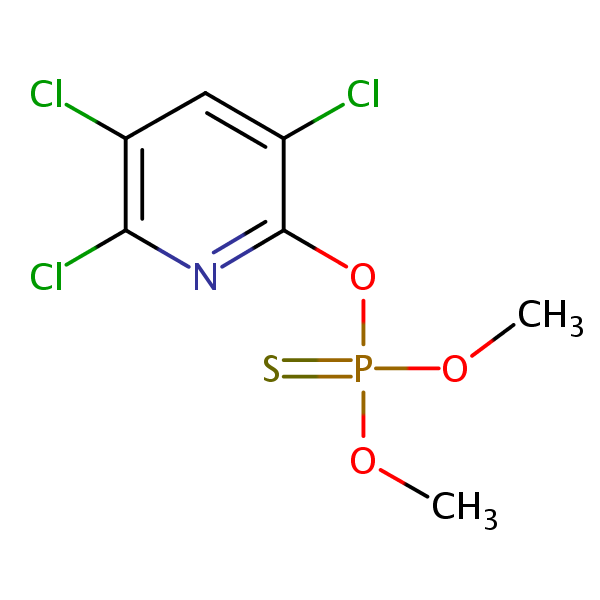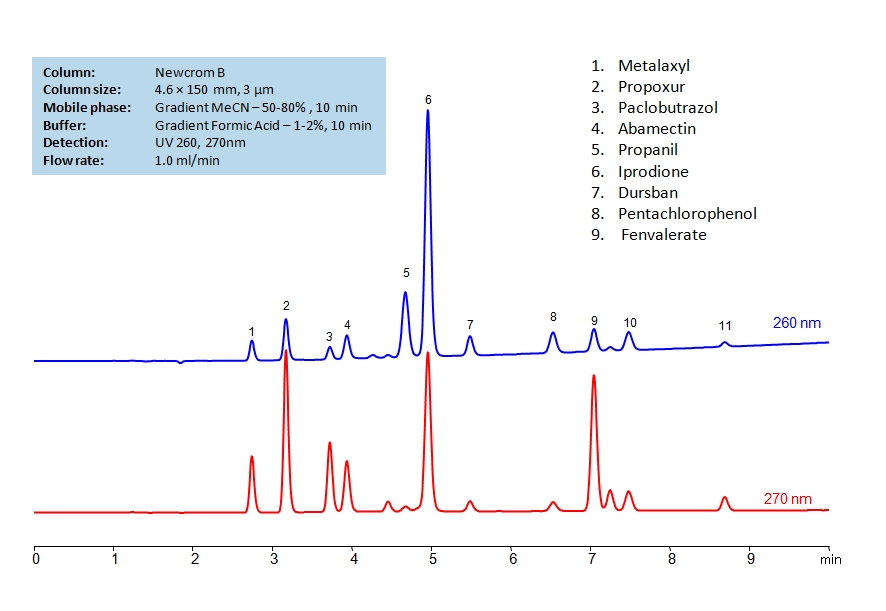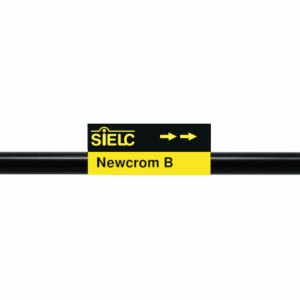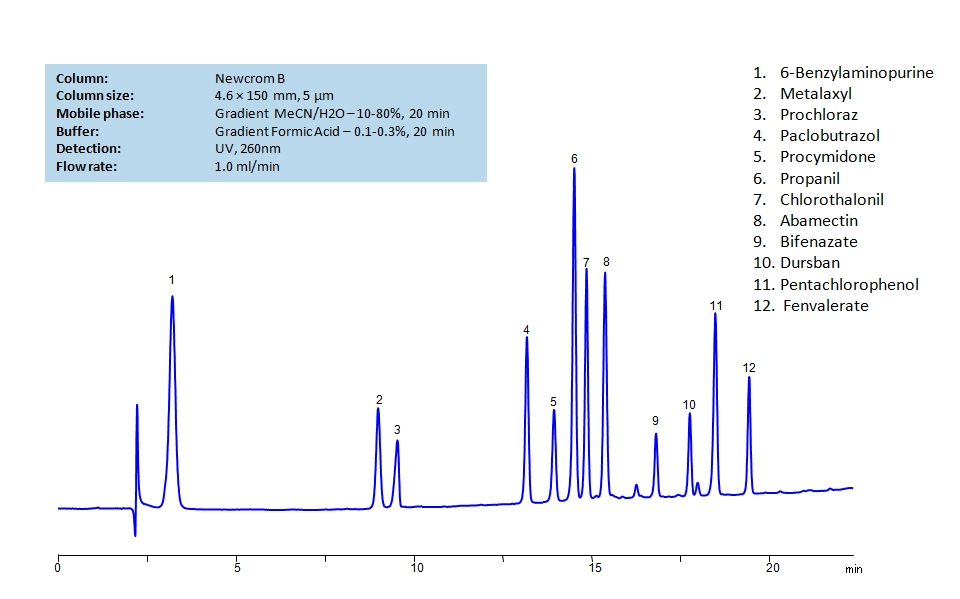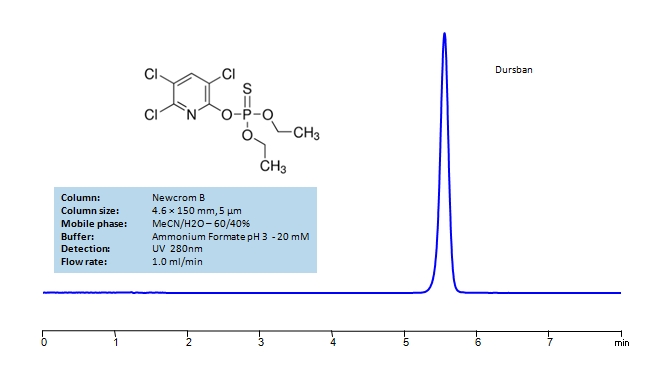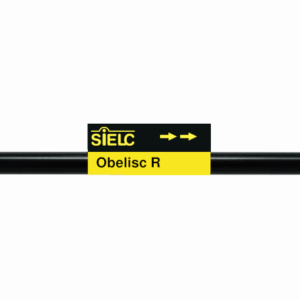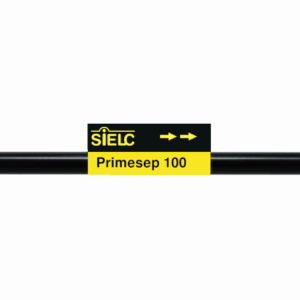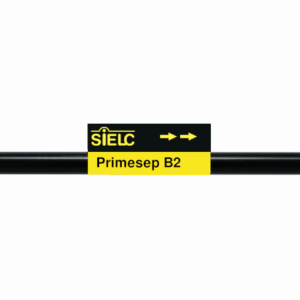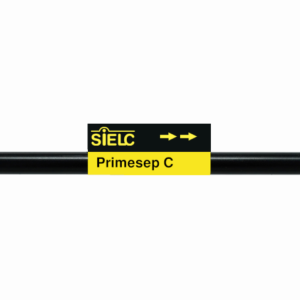| CAS Number | 5598-13-0 |
|---|---|
| Molecular Formula | C7H7Cl3NO3PS |
| Molecular Weight | 322.520 |
| InChI Key | HRBKVYFZANMGRE-UHFFFAOYSA-N |
| LogP | 4.31 |
| Synonyms |
|
Applications:
HPLC Separation of Pesticides on Newcrom B Column
February 3, 2020
HPLC Method for Metalaxyl (UV), Propoxur, Paclobutrazol, Abamectin, Propanil, Iprodione, Chlorpyrifos-methyl (Dursban), Pentachlorophenol, Fenvalerate on Newcrom B by SIELC Technologies
High Performance Liquid Chromatography (HPLC) Method for Analysis of Metalaxyl (UV), Propoxur, Paclobutrazol, Abamectin, Propanil, Iprodione, Chlorpyrifos-methyl (Dursban), Pentachlorophenol, Fenvalerate.
Metalaxyl, also known as methyl N-(methoxyacetyl)-N-(2,6-xylyl)-DL-alaninate, is a systemic fungicide with the chemical formula C15H21NO4. It is used to control Pythium and Phytophthora in vegetables. It has suffered a resistance problem going back to the 1980s.
Propoxur is a non-systemic insecticide produced from catechol with the chemical formula C11H15NO3. It has a variety of uses from turf, forestry, and agricultural pests to household pests and fleas.
Paclobutrazol (PBZ) is a synthetic triazole compound with the chemical formula C15H20ClN3O. It is used to control plant growth as an antagonist of the plant hormone gibberellin. Through reducing reducing internodal growth, it causes stronger stems, greater root growth, and earlier fruitset. It can also reduce frost sensitivity in plants.
Abamectin is a insecticide with the chemical formulas C48H72O14 and C47H70O14. It is also used to control fire ant populations. In veterinary cases, it is used to deworm horses as well as an antihelmintic.
Propanil is a contact herbicide with the chemical formula C9H9Cl2NO. It is one of the most widely used herbicides in America. It works as an inhibitor of photosynthesis and CO2 fixation in weeds.
Iprodione is a hydantoin fungicide and nematicide with the chemical formula C13H13Cl2N3O3. It is used on a wide variety of crops that are affected by fungal diseases such as botrytis bunch rot, brown rot, and Sclerotinia. Approval of using it is different across the world.
Dursban is a highly toxic organophosphate with the chemical formula C9H11Cl3NO3PS. It works through interrupting the electrochemical processes in nerves. This leads to a build-up of acetylcholine, which leads to paralysis and eventual death.
Pentachlorophenol is a manufactured chemical with the chemical formula C6HCl5O. It is most often used as herbicide, insecticide, fungicide, algaecide, and disinfectant. Exposure to it can cause damage to liver, kidney, blood, lungs, eyes, skin, and mouth. It is classified as a probable human carcinogen.
Fenvalerate is synthetic pyrethroid insecticide with the chemical formula C25H22ClNO3. It is used against a wide range of pests, partially due to it’s moderate mammalian toxicity following short-term and acute exposure. It is the most toxic to bees and fish. Upon contact, it may irritate skin and eyes.
Metalaxyl (UV), Propoxur, Paclobutrazol, Abamectin, Propanil, Iprodione, Chlorpyrifos-methyl (Dursban), Pentachlorophenol, Fenvalerate can be retained and analyzed using the Newcrom B stationary phase column. The analysis utilizes an isocratic method with a simple mobile phase consisting of water and acetonitrile (MeCN) with a formic acid buffer. Detection is performed using UV.
| Column | Newcrom B, 4.6 x 150 mm, 3 µm, 100 A, dual ended |
| Mobile Phase | MeCN/H2O |
| Buffer | Formic Acid |
| Flow Rate | 1.0 ml/min |
| Detection | UV, 260, 270 nm |
| Class of Compounds | Hydrophobic, Herbicide, Pesticide |
| Analyzing Compounds | Metalaxyl (UV), Propoxur, Paclobutrazol, Abamectin, Propanil, Iprodione, Chlorpyrifos-methyl (Dursban), Pentachlorophenol, Fenvalerate |
Application Column
Newcrom B
Column Diameter: 4.6 mm
Column Length: 150 mm
Particle Size: 3 µm
Pore Size: 100 A
Column options: dual ended
Chlorpyrifos-methyl (Dursban)
Fenvalerate
Iprodione
Metalaxyl (UV)
Paclobutrazol
Pentachlorophenol
Propanil
Propoxur

HPLC Separation of 12 Pesticides on Newcrom B Column
January 24, 2020
HPLC Method for 6-Benzylaminopurine, Metalaxyl (UV), Prochloraz, Paclobutrazol, Propanil, Chlorothalonil, Chlorpyrifos-methyl (Dursban), Pentachlorophenol, Fenvalerate, Abamectin, Procymidone, Bifenazate on Newcrom B by SIELC Technologies
High Performance Liquid Chromatography (HPLC) Method for Analysis of 6-Benzylaminopurine, Metalaxyl (UV), Prochloraz, Paclobutrazol, Propanil, Chlorothalonil, Chlorpyrifos-methyl (Dursban), Pentachlorophenol, Fenvalerate, Abamectin, Procymidone, Bifenazate.
6-Benzylaminopurine is a plant growth regulation compound with the molecular formula C12H11N5. It’s presence in asparagus, for example, leads to deeper color, increased firmness, and a decrease in fibrous hardness. In general, it stimulates cell division and differentiation.
Metalaxyl, also known as methyl N-(methoxyacetyl)-N-(2,6-xylyl)-DL-alaninate, is a systemic fungicide with the chemical formula C15H21NO4. It is used to control Pythium and Phytophthora in vegetables. It has suffered a resistance problem going back to the 1980s.
Prochloraz is an imidazole fungicide with the chemical formula C15H16Cl3N3O2. It is used widely across Europe, Asia, South America, and Australia, but is not registered for use in the United States. It works as an inhibitor of the enzyme lanosterol 14α-demethylase.
Paclobutrazol (PBZ) is a synthetic triazole compound with the chemical formula C15H20ClN3O. It is used to control plant growth as an antagonist of the plant hormone gibberellin. Through reducing reducing internodal growth, it causes stronger stems, greater root growth, and earlier fruitset. It can also reduce frost sensitivity in plants.
Procymidone is a pesticide and fungicide with the chemical formula C13H11Cl2NO2. It is typically used to kill unwanted ferns, nettles, and fungi in lupins, grapes, stone fruit, and strawberries.
Propanil is a contact herbicide with the chemical formula C9H9Cl2NO. It is one of the most widely used herbicides in America. It works as an inhibitor of photosynthesis and CO2 fixation in weeds.
Chlorothalonil is a compound with a variety of uses as a fungicide, wood protectant, pesticide, and acaricide. It is used predominantly on peanuts, potatoes, and tomatoes. Outside of agriculture, it is also used in paints, resins, emulsions, and coatings. It’s chemical formula is C8Cl4N2.
Abamectin is a insecticide with the chemical formulas C48H72O14 and C47H70O14. It is also used to control fire ant populations. In veterinary cases, it is used to deworm horses as well as an antihelmintic.
Bifenazate is pesticide with the chemical formula C17H20N2O3. It is typically used to control a large variety of mite pests in plants in various settings. It works through modulating GABA receptors and inhibiting complex III of the mitochondrial electron transport chain.
Dursban is a highly toxic organophosphate with the chemical formula C9H11Cl3NO3PS. It works through interrupting the electrochemical processes in nerves. This leads to a build-up of acetylcholine, which leads to paralysis and eventual death.
Pentachlorophenol is a manufactured chemical with the chemical formula C6HCl5O. It is most often used as herbicide, insecticide, fungicide, algaecide, and disinfectant. Exposure to it can cause damage to liver, kidney, blood, lungs, eyes, skin, and mouth. It is classified as a probable human carcinogen.
Fenvalerate is synthetic pyrethroid insecticide with the chemical formula C25H22ClNO3. It is used against a wide range of pests, partially due to it’s moderate mammalian toxicity following short-term and acute exposure. It is the most toxic to bees and fish. Upon contact, it may irritate skin and eyes.
6-Benzylaminopurine, Metalaxyl (UV), Prochloraz, Paclobutrazol, Propanil, Chlorothalonil, Chlorpyrifos-methyl (Dursban), Pentachlorophenol, Fenvalerate, Abamectin, Procymidone, Bifenazate can be retained and analyzed using the Newcrom B stationary phase column. The analysis utilizes an isocratic method with a simple mobile phase consisting of water and acetonitrile (MeCN) with a formic acid buffer. Detection is performed using UV.
| Column | Newcrom B, 4.6 x 150 mm, 5 µm, 100 A, dual ended |
| Mobile Phase | MeCN/H2O |
| Buffer | Formic Acid |
| Flow Rate | 1.0 ml/min |
| Detection | UV, 260 nm |
| Class of Compounds | Hydrophobic, Herbicide, Pesticide |
| Analyzing Compounds | 6-Benzylaminopurine, Metalaxyl (UV), Prochloraz, Paclobutrazol, Propanil, Chlorothalonil, Chlorpyrifos-methyl (Dursban), Pentachlorophenol, Fenvalerate, Abamectin, Procymidone, Bifenazate |
Application Column
Newcrom B
Column Diameter: 4.6 mm
Column Length: 150 mm
Particle Size: 5 µm
Pore Size: 100 A
Column options: dual ended
Abamectin
Bifenazate
Chlorothalonil
Chlorpyrifos-methyl (Dursban)
Fenvalerate
Metalaxyl (UV)
Paclobutrazol
Pentachlorophenol
Prochloraz
Procymidone
Propanil

HPLC Determination of Dursban on Newcrom B Column
January 6, 2020
HPLC Method for Chlorpyrifos-methyl (Dursban) on Newcrom B by SIELC Technologies
High Performance Liquid Chromatography (HPLC) Method for Analysis of Chlorpyrifos-methyl (Dursban).
Dursban is a highly toxic organophosphate with the chemical formula C9H11Cl3NO3PS. It works through interrupting the electrochemical processes in nerves. This leads to a build-up of acetylcholine, which leads to paralysis and eventual death.
Chlorpyrifos-methyl (Dursban) can be retained and analyzed using the Newcrom B stationary phase column. The analysis utilizes an isocratic method with a simple mobile phase consisting of water and acetonitrile (MeCN) with an Ammonium Formate buffer. Detection is performed using UV.
| Column | Newcrom B, 4.6 x 150 mm, 5 µm, 100 A, dual ended |
| Mobile Phase | MeCN/H2O – 60/40% |
| Buffer | AmFm pH 3.0 – 20 mM |
| Flow Rate | 1.0 ml/min |
| Detection | UV, 280 nm |
| Class of Compounds | Hydrophobic, Herbicide, Pesticide |
| Analyzing Compounds | Chlorpyrifos-methyl (Dursban) |
Application Column
Newcrom B
Column Diameter: 4.6 mm
Column Length: 150 mm
Particle Size: 5 µm
Pore Size: 100 A
Column options: dual ended

HPLC Retention of Chlorpyrifos-methyl on Primesep 100 and Obelisc R Mixed-Mode Columns
September 14, 2015
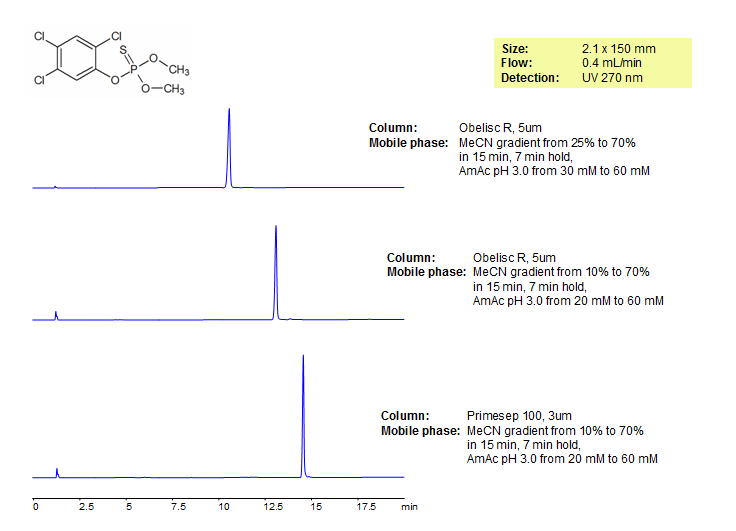
Chlorpyrifos-methyl, an organophosphate pesticide is considered a target pesticide by the EURL (European Union Reference Laboratory) for the EUPT-FF9 2015 a proficiency test for the analysis of a over a hundred pesticides. This compound was separated on two different mixed-mode columns, Primesep 100 and Obelisc R. Primesep 100 is a reverse phase column that contains embedded acidic ion-pairing groups, while Obelisc R retains with long hydrophobic chains and multiple ionic pairing groups on the surface. Method is LC/MS compatible and can be replicated to analyze dozens of other pesticides.
| Column | Obelisc R, 2.1×150 mm, 5 µm, 100A |
| Mobile Phase | Gradient MeCN – 25-70%, 15 min, 7 min hold |
| Buffer | Gradient AmAc pH 3.0- 30-60 mM, 15 min, 7 min hold |
| Flow Rate | 0.4 ml/min |
| Detection | UV, 270 nm |
| Column | Obelisc R, 2.1×150 mm, 5 µm, 100A |
| Mobile Phase | Gradient MeCN – 10-70%, 15 min, 7 min hold |
| Buffer | Gradient AmAc pH 3.0- 20-60 mM, 15 min, 7 min hold |
| Flow Rate | 0.4 ml/min |
| Detection | UV, 270 nm |
| Column | Primesep 100, 2.1×150 mm, 5 µm, 100A |
| Mobile Phase | Gradient MeCN – 10-70%, 15 min, 7 min hold |
| Buffer | Gradient AmAc pH 3.0- 20-60 mM, 15 min, 7 min hold |
| Flow Rate | 0.4 ml/min |
| Detection | UV, 270 nm |
| Class of Compounds |
Insecticide, Herbicide, Fungicide, Hydrophobic, Ionizable |
| Analyzing Compounds | Chlorpyrifos-methyl |
Application Column
Obelisc R
SIELC has developed the Obelisc™ columns, which are mixed-mode and utilize Liquid Separation Cell technology (LiSC™). These cost-effective columns are the first of their kind to be commercially available and can replace multiple HPLC columns, including reversed-phase (RP), AQ-type reversed-phase, polar-embedded group RP columns, normal-phase, cation-exchange, anion-exchange, ion-exclusion, and HILIC (Hydrophilic Interaction Liquid Chromatography) columns. By controlling just three orthogonal method parameters - buffer concentration, buffer pH, and organic modifier concentration - users can adjust the column properties with pinpoint precision to separate complex mixtures.
Select optionsPrimesep 100
The Primesep family of mixed-mode columns offers a wide variety of stationary phases, boasting unprecedented selectivity in the separation of a broad array of chemical compounds across multiple applications. Corresponding Primesep guard columns, available with all stationary phases, do not require holders. SIELC provides a method development service available to all customers. Inquire about our specially-tailored custom LC-phases for specific separations.
Select options
Chlorpyrifos-methyl Separation Using Obelisc and Primesep Columns
August 24, 2015
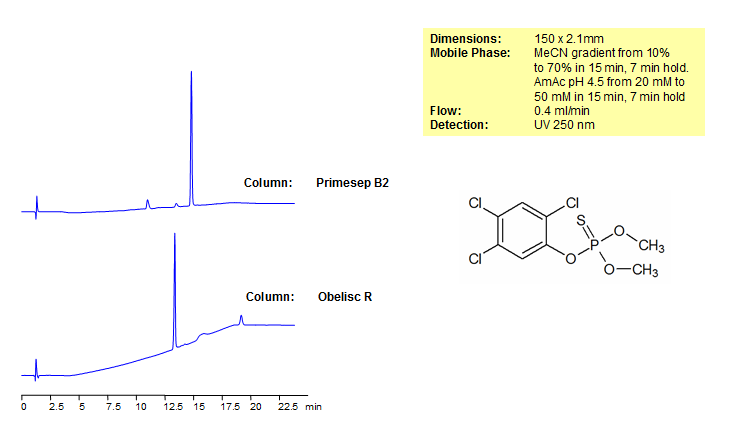
| Column | Primesep B2, 2.1×150 mm, 5 µm, 100A |
| Mobile Phase | Gradient MeCN – 10-70%, 15 min, 7 min hold |
| Buffer | Gradient AmAc pH 4,5- 20-50 mM, 15 min, 7 min hold |
| Flow Rate | 0.4 ml/min |
| Detection | UV, 250 nm |
| Column | Obelisc R, 2.1×150 mm, 5 µm, 100A |
| Mobile Phase | Gradient MeCN – 10-70%, 15 min, 7 min hold |
| Buffer | Gradient AmAc pH 4,5- 20-50 mM, 15 min, 7 min hold |
| Flow Rate | 0.4 ml/min |
| Detection | UV, 250 nm |
| Class of Compounds |
Insecticide, Herbicide, Fungicide, Hydrophobic, Ionizable |
| Analyzing Compounds | Chlorpyrifos-methyl |
Application Column
Obelisc R
SIELC has developed the Obelisc™ columns, which are mixed-mode and utilize Liquid Separation Cell technology (LiSC™). These cost-effective columns are the first of their kind to be commercially available and can replace multiple HPLC columns, including reversed-phase (RP), AQ-type reversed-phase, polar-embedded group RP columns, normal-phase, cation-exchange, anion-exchange, ion-exclusion, and HILIC (Hydrophilic Interaction Liquid Chromatography) columns. By controlling just three orthogonal method parameters - buffer concentration, buffer pH, and organic modifier concentration - users can adjust the column properties with pinpoint precision to separate complex mixtures.
Select optionsPrimesep B2
The Primesep family of mixed-mode columns offers a wide variety of stationary phases, boasting unprecedented selectivity in the separation of a broad array of chemical compounds across multiple applications. Corresponding Primesep guard columns, available with all stationary phases, do not require holders. SIELC provides a method development service available to all customers. Inquire about our specially-tailored custom LC-phases for specific separations.
Select optionsPrimesep C
The Primesep family of mixed-mode columns offers a wide variety of stationary phases, boasting unprecedented selectivity in the separation of a broad array of chemical compounds across multiple applications. Corresponding Primesep guard columns, available with all stationary phases, do not require holders. SIELC provides a method development service available to all customers. Inquire about our specially-tailored custom LC-phases for specific separations.
Select options
HPLC Analysis of Chlorpyrifos-methyl
August 10, 2015
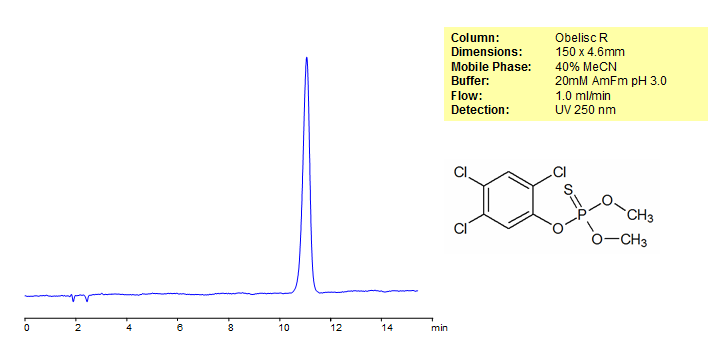
| Column | Obelisc R, 4.6×150 mm, 5 µm, 100A |
| Mobile Phase | MeCN – 30% |
| Buffer | AmFm pH 3.0- 20 mM |
| Flow Rate | 1.0 ml/min |
| Detection | UV, 250 nm |
| Class of Compounds |
Insecticide, Herbicide, Fungicide, Hydrophobic, Ionizable |
| Analyzing Compounds | Chlorpyrifos-methyl |
Application Column
Obelisc R
SIELC has developed the Obelisc™ columns, which are mixed-mode and utilize Liquid Separation Cell technology (LiSC™). These cost-effective columns are the first of their kind to be commercially available and can replace multiple HPLC columns, including reversed-phase (RP), AQ-type reversed-phase, polar-embedded group RP columns, normal-phase, cation-exchange, anion-exchange, ion-exclusion, and HILIC (Hydrophilic Interaction Liquid Chromatography) columns. By controlling just three orthogonal method parameters - buffer concentration, buffer pH, and organic modifier concentration - users can adjust the column properties with pinpoint precision to separate complex mixtures.
Select options
